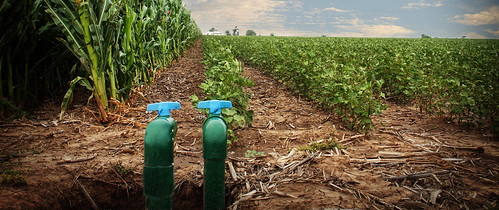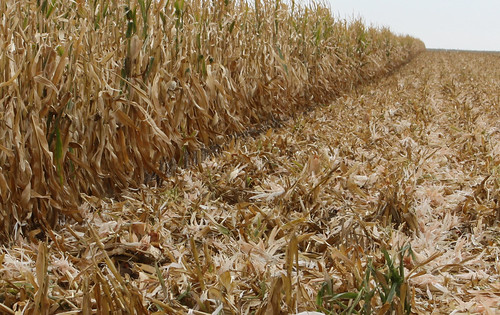
Multiple cropping systems were used in the demonstration including corn and cotton. Micro-subsurface drip irrigation was one of the irrigation systems used to irrigate crops and conserve water.
In the High Plains of Texas, water reigns. The area is one of the most productive agricultural regions in the world, making a reliable water supply key to the area’s rural economies.
The High Plains draws its water from the Ogallala Aquifer, an underground aquifer that spans eight states. Currently, the use of groundwater from the aquifer is unsustainable as withdrawals for cities, farms, ranches, industries and other uses exceed the natural recharge of the aquifer.
That’s why USDA is working with farmers and ranchers to find ways to stay productive while conserving use of water. Through a Conservation Innovation Grant from USDA, the North Plains Groundwater Conservation District is working to demonstrate emerging irrigation management and other conservation practices.
“The grant allowed the district, Texas Tech University, Texas Alliance for Water Conservation, the High Plains Underground Water Conservation District and demonstration growers to pool technical and financial resources to promote water conservation,” said Steve Walthour, the district’s general manager.
The project’s goal was to grow 200 bushels of corn with only 12 inches of irrigated water in addition to soil moisture and normal rainfall. Unfortunately, the project began amid the severe drought of 2011. So while they did not meet the goal, they were able to demonstrate how conservation practices, such as conservation crop rotation, strip tillage and residue management, can help make farms more resilient during drought.
Through the project, the district learned that crops grown with the drip irrigation systems in this project produced the highest crop yields and yield per inch of water applied. NRCS provides technical and financial assistance to producers wanting to install these systems.
Over the course of the project, more than 400 million gallons of water were conserved. If these water savings were applied across the entire district, they could conserve 163 billion gallons of water per year.
The grant from USDA helped the district pay for monitoring equipment and other cutting-edge technologies for the project as well as compensate farmers who participated in the project.
“NRCS was a natural source for that grant and the funding they provided was critical in the success of our demonstration,” Walthour said.
Overall, the goal of USDA and the district was to provide a guide for producers to maintaining thriving farms and ranches while using water wisely. USDA’s Natural Resources Conservation Service (NRCS) is working with producers in Texas and across the eight-state Ogallala Aquifer region to use water more efficiently and make other conservation improvements to their land.
Through the Ogallala Aquifer Initiative (OAI), NRCS is working with producers to increase water efficiency in the most vulnerable areas of the aquifer. From 2011 to 2014, NRCS invested $66 million in the initiative to help producers make conservation improvements to 325,000 acres. This week, NRCS announced its plans to invest $6.5 million this year to get conservation on the ground in priority areas.
“We know that NRCS-recommended conservation practices are working,” said Montie Hawks, the initiative’s coordinator. “When we take a look at our work with producers, we’re seeing that we’re making considerable headway in conserving billions of gallons of water each year.”
Watch “Critical Aquifer” to see this work in action.

Corn residue is left on the soil surface following harvest to conserve soil moisture and protect the soil from wind and water erosion.
No comments:
Post a Comment
Note: Only a member of this blog may post a comment.